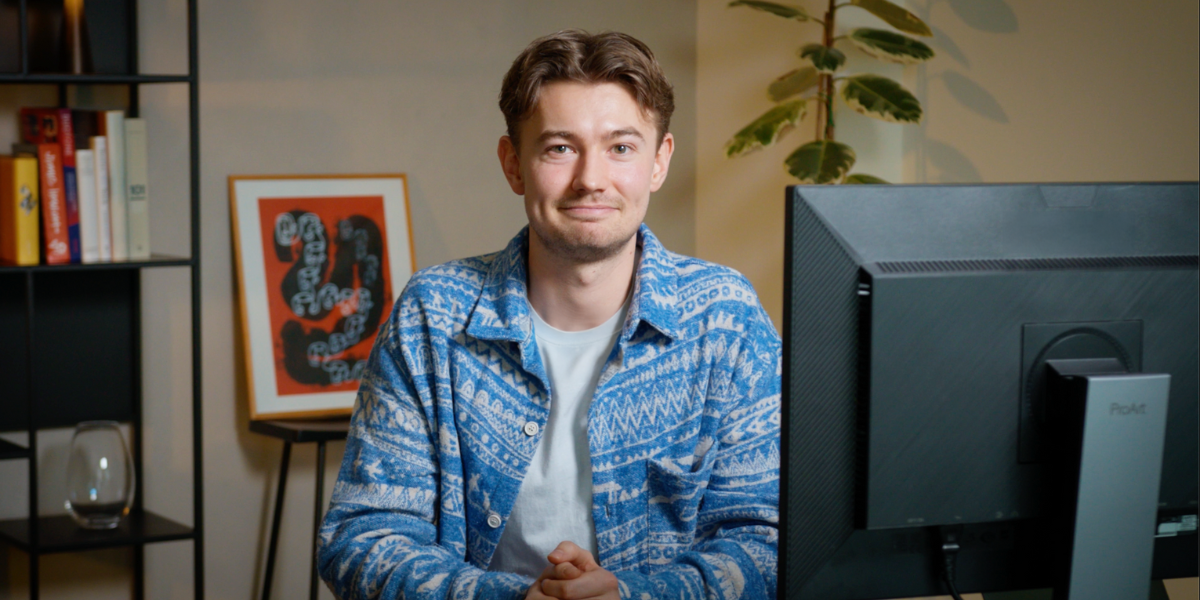Today, it seems like every piece of technology needs to have at least two functions (more realistically, five) to be considered competitive.
We can check our text messages on a smart fridge. We can check our sleep score to see how well we slept without thinking about how we feel.
We can buy a toothbrush that sends updates to our phone detailing how effective our brushing has been.
It's convenient, sure. But has this access to everything — everything — all at once affected how our brains work?

The Dawn of Smart Devices
The first smart device was the IBM Simon Personal Communicator, released in August 1994. At eight inches long and weighing over a pound, Simon wasn’t exactly the epitome of sleek.
Yet, at the time, it was darn impressive, because it allowed its user access to many functions (not yet called “apps”), including:
- Calculator
- Calendar
- Fax
- Alarm clock
- Notepad
- To-do list
Instead of having to walk to the fax machine to manually send a message (talk about a phrase that hasn’t been uttered in a decade), you could simply type into this tiny box and be on your way.
From this point, humans were hooked on multi-functionality. And very rapidly, we expanded upon IBM’s vision.
Realizing the Effects of Smart Devices on Mental Health
In the thirty years since Simon was released, we’ve moved light-years ahead in what smart devices can do. With smart glasses, smart rings, smart watches, and (of course) smartphones all now available, fairly affordable, and rapidly evolving, we have the chance to be connected every second of every day.
In response, many scientists and psychologists have set out to determine exactly how this instant access to everything under the sun affects our emotional, behavioral, and mental health.
The results are about what you’d expect. Studies have shown just how dependent we’ve become on our smartphones, with nearly half of the respondents of one study by the Pew Research Center saying they would be “unable to live without their phone” and that being separated from their phone results in feelings of “anxiety and withdrawal.” Dependence on smart devices is a very real phenomenon affecting today’s population, particularly younger generations, who have never known a world without this kind of technology.
With 95% of teens ages 13-17 having access to a smartphone, emerging research has found that a person’s hours of screen time per day directly correlates to adverse mental health effects. In one eleven-year survey by Gunnell and colleagues, researchers found that an increase in screen time was associated with an increase in anxiety and depression in children and young adults.
Studies have shown just how dependent we’ve become on our smartphones, with nearly half of the respondents of one study by the Pew Research Center saying they would be "unable to live without their phone."
Additionally, one of the most-cited consequences of smart device use has been a disturbance of sleep. Many of us have heard of the idea of going “screen-less” for the last hour of our waking day.
There are several reasons for this. The blue light emitted from our phones, laptops, and tablets can throw off our body’s internal clock. At the same time, doing thought-heavy activities like playing games or thinking of a witty response to fire back to a friend can continue to stimulate the mind, rather than winding it down for sleep.
But there’s another process that many of us fall victim to every week: revenge bedtime procrastination.
Essentially, during our busy day, we feel like we can’t get a moment to ourselves. So, once we get into bed, we hop on our smart device and scroll, absorbing all the content we can. We’re determined to carve out a little personal time — even if that comes at the price of fragmented sleep.
Poor sleep from this cycle can weaken our ability to make decisions, while increasing anxiety and depression.
Our Dwindling Need to Recall Knowledge
In addition to affecting stress levels and sleep quality, some researchers suggest that our way of learning and absorbing information has changed after using these devices so regularly for so long.
Imagine that it’s thirty years ago, and your sink is leaking.
Well, in 1994, “Google” was not a verb; in fact, it wasn’t even a word. This meant that you couldn’t simply type “how to fix leak” into a search bar and be gifted with a step-by-step guide on what to do.
Instead, you’d likely go through some trial and error to see if you could figure out how to stop that leak, which would require a significant amount of brainpower and problem-solving.
Today, we don’t have to go through this thought-stimulating process. Instead, we simply type a few letters on our screen, and we’re given exact steps to accomplish what we need.
The problem? Having this constant access to technology may affect our ability to recall information we’ve previously learned. It makes sense — why should our mind spend the brainpower retaining this information when we can effortlessly look it up again if we need it?
(And smart devices' effect on our ability to focus? Our utter inability to multitask? Those are whole separate topics!)
Having this constant access to technology may affect our ability to recall information we've previously learned.
This constant access to information has also led to a decline in an essential aspect of our mental health: socialization.
Let’s say it's still 1994 and you haven’t been able to fix that annoying leak in your sink. To get some assistance, you may head down to the hardware store to ask an associate for advice. Or you might call your dad.
While these interactions may seem inconsequential, we know that these social interactions are essential to our brain health. Unfortunately, people today are experiencing fewer and fewer encounters like these due to the isolating nature of smart devices.
Breaking Our Dopamine Addiction
There's another sneaky process at work in fueling our addiction to smart devices. Constantly checking notifications, whether it be a text, comment on an Instagram post, or a reminder to play Wordle, has been found to give our brains a boost in dopamine.
Dopamine is a neurotransmitter that can help us feel pleasure. This is why seeing that someone left a comment on your Facebook post (or TikTok, depending on your generation) can leave you feeling a certain kind of high.
However, dopamine isn’t all rainbows and good feelings. When you obtain regular spikes in dopamine, your body begins to need more dopamine to continue to feel that pleasure. So, you need to check your notifications more and more often to continue to get that positive feeling.
And when that person isn’t checking their alerts — what happens?
They experience more emotional lows. These low feelings can lead to more stress and anxiety that can impact all aspects of life.
It's far past time we re-regulate how much dopamine our brains get — and hopefully, move into a healthier, more natural cycle.
It's far past time we re-regulate how much dopamine our brains get — and hopefully, move into a healthier, more natural cycle.
The Difference of a Single-Purpose Device
With all this emerging research on the effects of smart devices, the idea of moving back toward simplicity and “doing one thing well” has become a major discussion in the tech world in recent years.
A single-purpose device is exactly what it sounds like: a device that has one function and one function only. For example, a fridge that merely keeps your food cold rather than reading you the weather report.
As these sole-use products continue to rise in popularity, we’ll no doubt see more studies comparing the mental health implications of using a single-feature product versus a smart device. But we can already draw some conclusions from smart device-focused research.
It’s been found that, on average, people check their email between 11 and 36 times per hour. This can mean that during the work day, a person is checking their email, Slack, or another communication app every six minutes.
Six minutes!
How can you get a workflow going if you’re interrupting yourself ten times an hour? Already we can see the benefits of stripping away distractions to focus on mentally taxing tasks like reading and writing.
Of course, many people still have plenty of non-technological single-purpose items we use daily: a coffee maker that strictly brews coffee; a dresser that holds your clothes; a mechanical watch that does not keep track of your step count. Rather than that jolting nuclear-alarm-meltdown sound that is the default on the iPhone, many people elect to set a physical alarm clock to wake them up.
These items do one purpose well, and that’s all we need (and expect) from them. In some ways, it’s reassuring to experience that focus. It’s also better for your brain.
However, it’s important to point out that single-purpose devices don't necessarily need to be non-technical. There are exceptionally fancy alarm clocks available today, from ones that roll around the floor to others that mimic the rising sun. Yet, most of these are not also allowing you to check your emails first thing in the morning.
And that's a good thing.
Teams like those here at Freewrite and over at brands like Light Phone and Brick are developing great single-purpose tech to help you do more of what you love without sacrificing your mental health.
Storytellers who do their best work when disconnected from their Slack pings often opt to use a dedicated drafting device from our lineup. Just like a Kindle offers distraction-free reading, Freewrite enables a writer to write distraction-free to their heart’s content.
This has led to the Freewrite community reporting that they average writing two to three times more words per hour on a single-purpose Freewrite device.
In other words: We can embrace new technology while also interrogating its effect on human beings and modern life.
Both are possible. I promise.
We can embrace new technology while also interrogating its effect on human beings and modern life.
Integrating the Single-Purpose Philosophy into Your Life
From higher productivity to less stress and better sleep, the data is pretty clear that we’d all benefit from less time on our smart devices.
We encourage you to explore the work being done at likeminded tech companies to see if you and your health could benefit from single-purpose technology. There are analogue changes you can make, too.
For example, you can use your bed for sleeping only. When you wake up, no scrolling through social media. Before bed, don’t cozy up to watch the newest episode of Bridgerton. No more enjoying a snack under your covers.
Your bed becomes designated for sleep and sleep alone. (Yes, sleep experts recommend this!)
If you have a single-purpose tool you love, we want to hear from you! Share it on social media and tag us @getfreewrite.




























